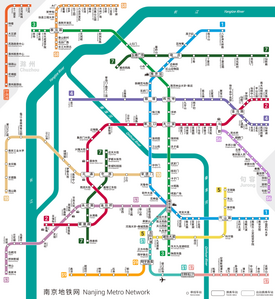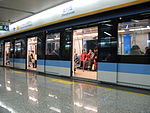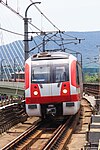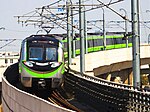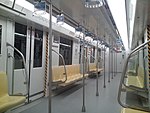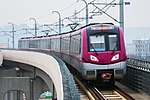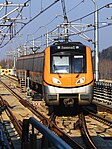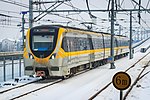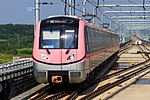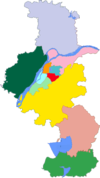Nanjing Metro
This article needs to be updated. (March 2024) |
| Nanjing Metro | |||
|---|---|---|---|
 | |||
 | |||
| Overview | |||
| Native name | |||
| Chinese name | |||
| Simplified Chinese | 南京地铁 | ||
| |||
| Locale | Nanjing, Jiangsu | ||
| Transit type | Rapid transit | ||
| Number of lines | 14 | ||
| Number of stations | 236 (active stations) | ||
| Daily ridership | 3.106 million (March 2018 avg.)[1] 4.00854 million (March 8, 2019 peak)[2] | ||
| Annual ridership | 977.4 million (2017)[3] | ||
| Website | njmetro.com.cn | ||
| Operation | |||
| Began operation | 3 September 2005[4] | ||
| Operator(s) | Nanjing Metro Group Co., Ltd. (南京地铁集团有限公司) | ||
| Technical | |||
| System length | 521 km (324 mi) | ||
| Track gauge | 1,435 mm (4 ft 8+1⁄2 in) standard gauge | ||
| Electrification | 1,500 V DC overhead lines (exclude line S4) 25kV AC overhead lines (line S4) | ||
| |||
The Nanjing Metro is a rapid transit system serving the urban and suburban districts of Nanjing, the capital city of Jiangsu Province in the People's Republic of China.
Proposals for a metro system serving Nanjing first began in 1984, with approval by the State Planning Commission granted in 1994. Construction began on the initial 16-station Line 1 in 1999, and opened in 2005. The system has 14 lines and 236 stations running on 521 km (324 mi) of track. It is operated and maintained by the Nanjing Metro Group Company. Future expansion plans include 30 lines set to open within the next few years, with several more awaiting approval to begin construction.
History
[edit]Early proposals
[edit]In 1984 the first serious proposal for construction of a subway appeared in the Municipal People's Congress.[5] In April 1986, the Nanjing Integrated Transport Planning group was established to research on how to implement a subway system in Nanjing. In December 1986 the team published the "Nanjing Metro Initial Phase". The phase consists of a north–south line, east–west line and a diagonal Northwest to Southeast line. The three lines meet in the city center forming a triangle.[6] A revision of the "Nanjing City Master Plan" in 1993 added another line through the urban core, and three light metro lines connecting Nanjing's suburbs in Pukou and the at time proposed new airport. In addition a suburban railway to Longtan was proposed. A 1999 report on "Nanjing city rapid rail transit network planning" further proposed six subway lines, two subway extensions and three light metro lines.[7]
In 1994, the State Planning Commission approved the preparatory work for the subway only to have the entire metro project postponed in 1995 amid a national freeze on new metro projects.[8]
Major changes were made to "Nanjing Urban Rail Transit Network Planning" in 2003.[citation needed] The new master plan consisted of 13 lines, of which nine are subway lines and four are light metro lines. The new Line 6 will be a loop line connecting all the urban radial lines. The plan retained the original lines 1, 2 and 3 from the previous plan. According to the new plan, the initial phase would consist of the completion of Metro Line 1 and 2 by 2010. Together the two lines will form a basic "cross" network. By 2020 the completion of Lines 1, 2, 3, and 4 was to form a more robust "pound" shaped (#) network. Longer-term plans include the construction of a loop line connecting all existing lines. The plan also identified four subway lines crossing the Yangtze river.
First line
[edit]The initial section of Line 1 from Maigaoqiao to Xiaohang received final official approval in 1999. In May 2000, the Experimental Station resumed construction with the entire Line 1 project in full construction in December.
A western extension of Line 1 from Xiaohang to a newly built stadium was fast tracked after Nanjing won hosting the National Games. Line 1's initial section and the western extension started trial operations on September 3, 2005, running from Maigaoqiao to Olympic Stadium with 16 stations and a total length of 21.72 kilometers (13.50 mi).[5] The opening of the Nanjing Metro Line 1 gave Nanjing the sixth metro system in the Chinese mainland after Beijing, Tianjin, Shanghai, Guangzhou and Shenzhen.
Lines in operation
[edit]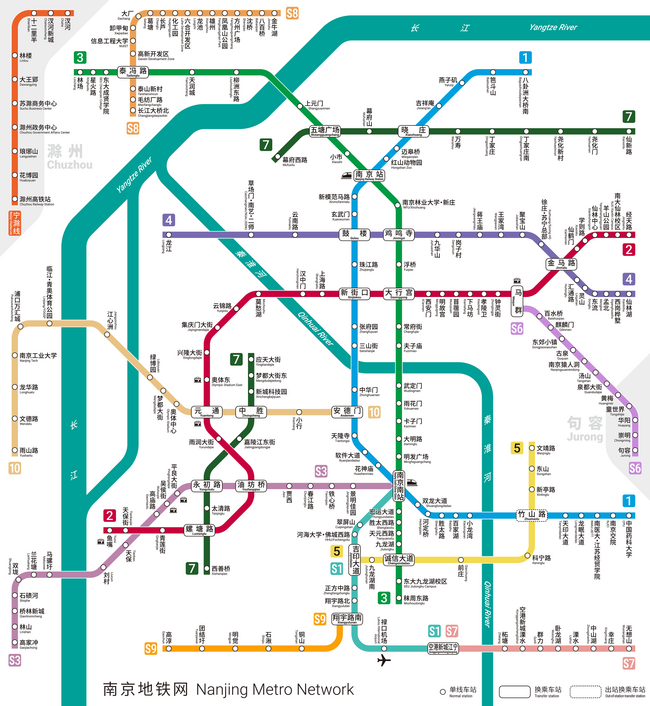
| Line | Termini (District) | Opening | Newest extension | Length | Stations | |
|---|---|---|---|---|---|---|
| 1 | Baguazhoudaqiaonan (Qixia) |
CPU (Jiangning) |
3 September 2005 | 28 December 2022 | 45.44 km (28.24 mi)[9] | 32 |
| 2 | Yuzui (Jianye) |
Jingtianlu (Qixia) |
28 May 2010 | 28 December 2021 | 43.6 km (27.1 mi)[10] | 30[10] |
| 3 | Linchang (Pukou) |
Mozhoudonglu (Jiangning) |
1 April 2015 | 18 October 2015 | 44.9 km (27.9 mi)[11] | 29[11] |
| 4 | Longjiang (Gulou) |
Xianlinhu (Qixia) |
18 January 2017 | n/a | 33.8 km (21.0 mi)[12] | 18[12] |
| 5 | Jiyindadao (Jiangning) |
Wenjinglu (Jiangning) |
31 March 2024 | n/a | 12.9 km (8.0 mi) | 9 |
| 7 (North) | Mufuxilu (Gulou) |
Xianxinlu (Qixia) |
28 December 2022 | n/a | 13.84 km (8.60 mi) | 10 |
| 7 (South) | Yingtiandajie (Jianye) |
Xishanqiao (Yuhuatai) |
28 December 2023 | n/a | 10.66 km (6.62 mi) | 9 |
| 10 | Andemen (Yuhuatai) |
Yushanlu (Pukou) |
1 July 2014 | n/a | 21.6 km (13.4 mi)[13] | 14[13] |
| S1 | Nanjing South Railway Station (Yuhuatai) |
Konggangxinchengjiangning (Jiangning) |
1 July 2014 | 26 May 2018 | 36.3 km (22.6 mi)[14] | 9[14] |
| S3 | Nanjing South Railway Station (Yuhuatai) |
Gaojiachong (Pukou) |
6 December 2017 | n/a | 36.3 km (22.6 mi)[15] | 19[15] |
| S4 | Chahe (Chuzhou) |
Chuzhou Railway Station (Chuzhou) |
28 June 2023 | n/a | 46.2 km (28.7 mi) | 10 |
| S6 | Maqun (Qixia) |
Jurong (Jurong) |
28 December 2021 | n/a | 43.6 km (27.1 mi)[16] | 13[16] |
| S7 | Konggangxinchengjiangning (Jiangning) |
Wuxiangshan (Lishui) |
26 May 2018 | n/a | 28.8 km (17.9 mi)[17] | 9[17] |
| S8 | Changjiangdaqiaobei (Pukou) |
Jinniuhu (Luhe) |
1 August 2014 | 30 September 2022 | 47.3 km (29.4 mi)[18] | 19[18] |
| S9 | Xiangyulunan (Jiangning) |
Gaochun (Gaochun) |
30 December 2017 | n/a | 52.4 km (32.6 mi)[19] | 6[19] |
| Total | 521 km (324 mi) | 212[a] | ||||
- a Discrepancies between these figures are explained by interchange stations. If interchange stations are counted once for each line they serve, there would be 236 stations.

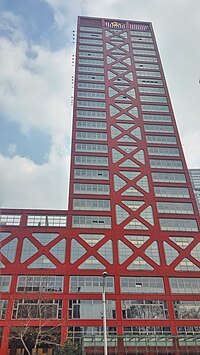
Line 1
[edit]Line 1 runs mainly in a north–south direction. The line starts at Maigaoqiao in the north, heading southwards to CPU (China Pharmaceutical University). The construction of Line 1 began in the year 2000 and was inaugurated on September 3, 2005, with 16 stations and a length of 21.72 kilometers (13.50 mi).[20] On May 28, 2010, Line 1's 24.5-kilometer (15.2 mi) long south extension entered into operation.[21][22] Thus, before the transfer of Line 1's Olympic Stadium Branch to Line 10, Line 1 was 46.2-kilometer (28.7 mi) long with 31 stations.[citation needed] The Olympic Stadium branch line broke away from Line 1 and formed parts of Line 10,[23] when the latter's construction finished and entered operation on July 1, 2014. Currently, Line 1 is 38.9-kilometer (24.2 mi) long with 27 stations.[24] Line 1's color is light blue.
Line 2
[edit]Line 2 is 43.4-kilometer (27.0 mi) long and has 30 stations.[10] It runs mainly in an east–west direction, from Yuzui in the southwest to Jingtianlu in the northeast. It entered into operation on May 28, 2010.[21][22] On 28 December 2021, the line was extended west 5.4 kilometers (3.4 mi) with 4 new stations to Yuzui Station.[25] Line 2's color is red.
Line 3
[edit]Groundbreaking work for Line 3 started in January 2010. This line, with a north–south orientation, started operation on April 1, 2015[26] and is 44.9 kilometres (27.9 mi) in length with 29 stations.[11] Line 3's color is green.
Line 4
[edit]Construction of east–west Line 4 begun in late 2012[27] and the first phase entered operation on January 18, 2017. The completed portion is 33.75 kilometers (20.97 mi) in length.[28] The line is known as A Zi (the Purple) as the branding for the line and the train color is purple, the first of which were delivered in April 2015.[29] The line started operation on January 18, 2017.[30] Line 4's color is purple.
Line 5
[edit]Line 5 opened its southern section on March 31, 2024 that is 12.9 kilometers long with nine stations.[31] Line 5's color is yellow.
Line 7
[edit]Line 7 is a northeast–southwest line roughly following the south bank of the Yangtze River.[32] The south section has been under construction since November 2017.[33] The rest of the line started construction in November 2018.[34] The north section opened on 28 December 2022,[35] and the south section from Yingtiandajie to Xishanqiao opened on 28 December 2023. This line is also the first line of Nanjing Metro to use trains in GoA4 automated level. Line 7's color is dark green.
Line 10
[edit]Line 10 is a western extension from Line 1's Olympic Stadium branch line, which broke away from Line 1 and formed part of Line 10 when the new line was completed. Construction started in February 2012,[36] finished in 2014. The line is approximately 21.6-kilometer (13.4 mi) long with 14 stations,[13] and entered operation on July 1, 2014.[37] Line 10's color is beige.
Line S1
[edit]Line S1 acts as Nanjing's airport express line, connecting Nanjing South Railway Station to Gaochun District via Nanjing Lukou International Airport. The entire line was planned to be 85.8-kilometer (53.3 mi) long with 13 stations.[38] The first phase from Nanjing South to Lukou International Airport started construction on December 27, 2011, and finished in 2014. The first phase opened on July 1, 2014, in time for the Nanjing 2014 Summer Youth Olympics. It is 35.8-kilometer (22.2 mi) long with 8 stations.[14] The second phase extension later became Line S9.[39] Line S1's color is teal.
Line S3
[edit]Line S3 opened on 6 December 2017. It starts from Nanjing South Railway Station and heads west, crossing the Yangtze River on the cantilever along the edge of Dashengguan Yangtze River bridge together with high-speed rail trains, before terminating at the Gaojiachong station in Qiaolin, southwest of Pukou District. Originally planned as Metro Line 12 or the Ninghe Intercity Rail Line, the route started construction in late 2011. Besides Nanjing South Railway Station in which passengers can transfer to Lines 1, 3, or S1, Youfangqiao station is also a transfer station between Line S3 and Line 2.[40][41] Phase one is 37.53 kilometers (23.32 mi) long with 19 stations[42] and connects Nanjing South Railway Station to Jiangbei New Area in Pukou. Phase 2 is now still being planned, which might extends further southwest from Phase 1 to Hexian county in the far future.[43] Line S3's color is magenta.
Line S4
[edit]Line S4 or the Nanjing-Chuzhou Intercity Railway is a 46.2 kilometers (28.7 mi) rapid transit line connecting Nanjing North railway station with neighboring Chuzhou city in Anhui province. The line will feature passing loops at select stations to allow for distinct express and local services.[44] Chuzhou section of the line is opened on 28 June 2023.[45] An extension to Nanjing North railway station is under construction. The Chuzhou section of the line will use the separated "Chuzhou Rail Transit" logo.[46]
Line S6
[edit]Line S6 or the Nanjing-Jurong Intercity Railway is a 43.7 kilometers (27.2 mi) connecting suburban Nanjing with neighboring Jurong opened on 28 December 2021. It is the first line in Nanjing Metro that reaches other cities, starting at Maqun station, ending at Jurong station. Line S6's color is lilac.
Line S7
[edit]Line S7 opened on 26 May 2018. It is an extension of Line S1 further southeast, starting at Konggangxinchengjiangning station, ending at Wuxiangshan station in South Lishui District. Some Line S1 trains continue to operate into Line S7. Line S7's color is pink.
Line S8
[edit]Line S8 is a suburban metro line which connects Luhe District to Pukou District. The line is 45.2 kilometers (28.1 mi) long,[18] 34.1 kilometers (21.2 mi) of the line is elevated. The line features 17 stations[18] including 6 underground stations and 11 elevated ones. It uses B size trains in 4 car sets that are capable of running up to 100 kilometers per hour (62 mph). Construction of the line started on June 21, 2012, and it was officially opened on August 1, 2014.[47][48] Line S8's color is orange.
Line S9
[edit]Line S9 starts from Xiangyulunan station, the 6th station from Nanjing South Railway Station on Line S1, and extends further south to Gaochun District for a total length of 52.42 km (32.57 mi). Upon opening on December 30, 2017, Nanjing became the first city in mainland China where every district is accessible by metro.[49] Line S9's color is yellow.
Future Development
[edit]Under-construction projects
[edit]
| Route | Name | Termini | Planned Opening | Length | Stations | Status | Notes | |
|---|---|---|---|---|---|---|---|---|
| 3 | Line 3 (Phase 3) | Mozhoudonglu | Molingjiedao | 2024 | 3 km | 2 | u/c since May 2021 | [50] |
| 4 | Line 4 (Phase 2) | Longjiang | Zhenzhuquan | 2025 | 9.7 km | 7 | u/c since February 2021 | |
| 5 | Line 5 (North section) | Fangjiaying | Wenjinglu | 2025 | 23.65 km | 21 | u/c since December 2016 | [51] |
| 6 | Line 6 | Qixiashan | Nanjing South railway station | 2024[52] | 32.4 km | 19 | u/c since December 2019 | [53] |
| 7 | Line 7 (Middle section) | Yingtiandajie | Mufuxilu | 2024 | 11.2 km | 8 | u/c since November 2017 | [54] |
| 9 | Line 9 (Phase 1) | Danxialu | Binjiang Park | 2025 | 19.67 km | 16 | u/c since March 2020 | |
| 10 | Line 10 (Phases 2) | Andemen | Shiyangdonglu | 2024 | 13.33 km | 10 | u/c since June 2020 | [55] |
| 11 | Line 11 (Phase 1) | Puzhoulu | Maluowei | 2026 | 27.0 km | 20 | u/c since November 2021 | [56] |
| S2 | Line S2 | Dangtu South Railway Station | Xishanqiao | 2025 | 54.4 km | 16 | u/c since December 2020 | [57][58] |
| S4 | Line S4 Nanjing-Chuzhou Intercity Railway | Nanjing North Railway Station | Chahe | 2025 (Nanjing section) | 8.2 km | 3 | u/c since December 2018[59] | [60] |
| S5 | Line S5 (Phase 1) | Xianlinhu | Yangzhou West Railway Station | 2026 | 57.61 km | 16 | u/c since December 2021 | [61] |
Line 5
[edit]Line 5 received approval on 14 January 2015.[62] Before the relocation in 2017, the line is projected to be 37.4 kilometers (23.2 mi) long, containing 30 stations and to cover a route from Fangjiaying station in Gulou District to Jiyindadao station in Jiangning District.[63]
Line 6
[edit]Line 6 is a 32.4 km fully underground line with 19 stations. Construction started on 28 December 2019.[64]
Line 9
[edit]Line 9 (Phase 1) is a 19.67 kilometers (12.22 mi) have a total of 16 stations, all of which are underground. The symbol of the train is orange red, and the maximum speed is 80 km/h. The route passes through Xuanwu District, Gulou District and Jianye District, and passes through Nanjing Railway Station, Xiaguan, Longjiang, Lüboyuan, Jiangsu Grand Theater and other areas. In the future, it will become an important line within the main city to connect the central Hexi, Xiaguan and Xinzhuang areas. The regional line is of great significance to the development of Hexi New City and the upgrading and reconstruction of the Xiaguan area. Construction started in May 2020, the construction period is about 4 years.[65] The list of stations: Danxialu, Caohouxun, Nanjing Railway Station, Zhongyangmen, Chenghecun, Daqiaonanlu, Xiaguan, Agricultural Trade Centre, Dinghuaimendajie, Longjiang, Guanziqiao, Hanzhongmendajie, Shuiximendajie, Qinghelu, Lüboyuan and Binjianggongyuan.[66] In the southern extension of Phase 2, Line 9 is expected to be extended all the way to Banqiao in the far south west of Nanjing.
Proposed projects
[edit]The Nanjing Metro Phase III construction plan was submitted to the National Development and Reform Commission in 2024.[67] The plan proposed 10 projects which include: 2 new lines, 7 extensions of existing lines and 1 shuttle line totalling 120km of new metro. The Nanjing Metro Phase III construction plan proposed Line 2 East Extension, 2-9 Shuttle Line, Line 3 Phase IV, Line 4 Phase III West Extension, Line 4 Phase III East Extension , Line 8 Phase I, Line 9 Phase II, Line 10 Phase III, Line 16 and Line S3 East Extension to be constructed.[68]
Ticket system
[edit]Fares on the Nanjing Metro are distance-based. Fares range from 2 yuan (approx US$0.30) for journeys under 4 kilometers, to 15 yuan for longer journeys.[69] There is a 5% discount for users of the Nanjing Public Utility IC Card. Fares can also be paid using Alipay, but with no discount.[70]
Single tickets
[edit]Single journey tickets can be purchased from the ticket vending machine or at a ticket window. The ticket vending machine accepts both coins, bills (¥5 and ¥10) and Alipay. [71]
Transit card
[edit]Apart from one-way tickets, fares can be paid with the Nanjing Public Utility IC Card, or Jinlingtong (Chinese: 金陵通; pinyin: Jīnlíngtōng). It can be purchased for a refundable fee of 25 yuan (about 3.8 dollars) and refilled at ticket booths inside the metro stations as well as many collaborative convenience stores throughout the city. The card can be used to pay for other means of public transportation, such as the city taxi and the city bus. An NFC version of the card is free of charge by applying from the iPhone's Wallet app.
This transit card is similar to Beijing's Yikatong, and the Octopus card of Hong Kong's MTR.
Rolling stock
[edit]- 20 six-car Alstom/Nanjing Puzhen Rolling Stock Works Metropolis sets - ordered in 2002 for Line 1 opening.[20]
- 21 six-car Alstom/Nanjing Puzhen Rolling Stock Works Metropolis ordered January 2008 for Line 1 extension.[21]
- 24 six-car Alstom/Nanjing Puzhen Rolling Stock Works Metropolis cars ordered 2007 for Line 2.[72]
- 26 four-car Alstom/Nanjing Puzhen Rolling Stock Works Metropolis cars ordered 2013 for Line S8.[73]
- 29 six-car Alstom/Nanjing Puzhen Rolling Stock Works Metropolis cars ordered 2013 for Line 4.[74]
Signalling system
[edit]For Line 1, Siemens Transportation Systems (TS) was awarded the supply contract in November 2002.
For Line 2, Siemens Transportation Systems (TS) and its local partner Nanjing Research Institute of Electronic Technology (NRIET) have been awarded to supply the signaling system after signing a contract (about 25 million Euro). Technologies used include Trainguard MT, Vicos OC 501, Sicas ECC and Az S 350 U axle counting system.[75]
Gallery
[edit]-
A Line 1 train approaching Hongshan Zoo station
-
A Line 1 train at Zhangfuyuan station
-
A line 2 train near Xianhemen station
-
A Line 3 train leaving Linchang station
-
A line 10 train approaching Xiaohang station
-
A view in Line 10 train carriage
-
Nanjing Line S3 train
-
A Line S8 train
-
A train of Nanjing Metro Line S9
-
A train of Nanjing Metro Line S7
See also
[edit]Notes
[edit]a Discrepancies between these figures are explained by interchange stations. If interchange stations are counted once for each line they serve, there would be 114 urban line stations, 50 S-line stations, and 164 total stations.
References
[edit]- ^ dt0001. 2018年3月南京地铁日均客流310.6万人次,比上月增加86.3万人次. 地铁族. Retrieved 2018-04-01.
{{cite web}}: CS1 maint: numeric names: authors list (link) - ^ 南京地铁 (2019-03-09). "Sina Visitor System" 【刷新纪录!妇女节南京地铁客流突破408万人次】. 新浪微博 (in Chinese). Retrieved 2019-03-12.
- ^ 城市地铁运输情况 2017年12月 [City Rail Transit Summary Dec 2017] (in Chinese). Nanjing Bureau of Statistics (南京市统计局). Archived from the original on 2018-02-15. Retrieved 2018-02-11.
- ^ 大事记. Nanjing Metro. Retrieved 2018-07-24.
9月3日 南京地铁一号线一期工程开通试运营
- ^ a b "南京地铁二十年梦圆". 扬子晚报. 2005-04-30.
- ^ 彭长生 (1993). "南京地铁一期工程与轨道交通规划". 都市快轨交通 (3).
- ^ 何宁,杨涛 (27 April 2005). "南京城市轨道交通规划:二十年规划 宏图变通途". 南京日报.
- ^ 国务院办公厅. "国务院办公厅关于暂停审批城市地下快速轨道交通项目的通知". 1995年12月28日. 中央政府网. Retrieved 2014-10-04.
- ^ 1号线 [Line 1] (in Simplified Chinese). Nanjing Metro. Archived from the original on October 7, 2016. Retrieved March 28, 2017.
- ^ a b c 宁句城际、南京地铁2号线西延线今日开通初期运营 [Nanjing-Jurong Line, Nanjing Metro Line 2 West Extension Enters Operation Today] (in Simplified Chinese). Sina News Jiangsu. Archived from the original on January 6, 2022. Retrieved January 5, 2022.
- ^ a b c 3号线 [Line 3] (in Simplified Chinese). Nanjing Metro. Archived from the original on October 7, 2016. Retrieved December 16, 2016.
- ^ a b 地铁四号线两站点本月开建 一期工程力争年内全面开工 [Metro Line 4 Begins Construction This Month] (in Simplified Chinese). Sina. August 14, 2012. Archived from the original on January 10, 2017. Retrieved December 16, 2016.
- ^ a b c 10号线 [Line 10] (in Simplified Chinese). Nanjing Metro. Archived from the original on October 7, 2016. Retrieved December 16, 2016.
- ^ a b c S1号线 [Line S1] (in Simplified Chinese). Nanjing Metro. Archived from the original on October 7, 2016. Retrieved December 16, 2016.
- ^ a b 宁和城际盾构隧道本月贯通 宁句城际目前已完成预可行性研究工作 [Ning-He Intercity Railway Tunnels Complete This Month, Ning-Ju Intercity Railway Completes Pre-Feasibility Study]. Xiandai Daily (in Simplified Chinese). August 16, 2016. Archived from the original on January 10, 2017. Retrieved December 18, 2016.
- ^ a b "宁句城际、地铁2号线西延线今开通" (in Simplified Chinese). Archived from the original on December 28, 2021. Retrieved January 5, 2022.
- ^ a b 宁溧城际全线开工2018年通车 [Nanjing Metro Ning-Li Line Will Open in 2018]. Xinhua News (in Simplified Chinese). April 11, 2016. Archived from the original on January 10, 2017. Retrieved December 18, 2016.
- ^ a b c d S8号线 [Line S8] (in Simplified Chinese). Nanjing Metro. Archived from the original on June 23, 2015. Retrieved December 16, 2016.
- ^ a b 宁高城际二期有望明年底通车全线设6座车站 [Ninggao Line's Six Stations May Open by the End of Next Year]. Renmin Daily (in Simplified Chinese). September 10, 2016. Archived from the original on January 10, 2017. Retrieved December 18, 2016.
- ^ a b "Nanjing metro inaugurated". Railway Gazette International. 1 October 2005. Retrieved 2014-07-03.
- ^ a b c "Nanjing Metro places €85·5m train order". Railway Gazette International. 25 January 2008. Retrieved 2014-07-03.
- ^ a b 南京地铁二号线载人模拟运营]. Sina News (in Chinese). Retrieved 2010-05-25.
- ^ 地铁1号线四站将于6月1日起开始割接 [Four Stations of Metro Line 1 will start from June 1 cutover] (in Chinese). 南京地铁官方网站 [Nanjing Metro official website]. 29 May 2014. Retrieved 2014-07-03.
- ^ 1号线 [Line 1] (in Chinese). 南京地铁集团有限公司 [Nanjing Metro Group Co., Ltd.] Retrieved 2015-07-09.
- ^ "南京轨道交通"大爆发" 15条线路同时开建".
- ^ "Nanjing metro Line 3 opens". Railway Gazette International. 2 April 2015. Retrieved 2015-04-04.
- ^ "China Daily Website - Connecting China Connecting the World" 南京地铁4号线年底前开工. China Daily. 5 September 2012. Retrieved 2012-10-07.
- ^ 南京地铁4号线主城“横贯线” 连创多个第一 [Metro Line 4, central city's "east-west line" achieves multiple firsts] (in Chinese). Nanjing Daily News. January 18, 2017. Archived from the original on 2017-01-26. Retrieved January 18, 2017.
- ^ "First Trainset of Nanjing Metro Line 4 Unveils". Nanjing China. 2 April 2015. Archived from the original on 2016-08-04. Retrieved 2016-05-28.
- ^ 南京地铁4号线“阿紫”开通试运营--图片频道--人民网. pic.people.com.cn (in Chinese (China)). Retrieved 2017-01-19.
- ^ "Hi 5! Nanjing's Newest Metro Line Opens; 8 Years in the Making". www.thenanjinger.com. 31 March 2024.
- ^ "南京地铁 7 号线工程" (PDF). www.jshbgz.cn. 南京地铁建设有限责任公司. Retrieved 2018-12-21.
- ^ "南京地铁七号线再次传来好消息! 将于11月29日全线开工--扬子晚报网". www.yangtse.com. Archived from the original on 2017-12-01. Retrieved 2018-12-21.
- ^ "南京地铁7号线11月29日开工 预计2021年通车--扬子晚报网". www.yangtse.com. Retrieved 2018-12-21.
- ^ "1号线北延线、7号线北段今日12时开通初期运营". 南京地铁. 2022-12-28.
- ^ 南京地铁三号线暨一号线西延过江线试验段开工 [Nanjing Metro Line Line 1-cum-west extension line test section over the river started]. www.ce.cn (www.chinaeconomy.cn) (in Chinese). 11 January 2010. Retrieved 2010-05-25.
- ^ 南京地铁10号线、机场线明晨6点通车 运营时刻早知道 [Nanjing Metro Line 10, the opening of the airport line tomorrow morning 6:00 to be operational at that time]. 扬子晚报网 [Yangzi Evening News Network] (in Chinese). 30 June 2014. Archived from the original on 14 July 2014. Retrieved 2014-07-03.
- ^ 地铁机场线、宁天城际一期工程传新动态 [Metro airport line, intercity one day pass new dynamic project]. www.HOUSE365.com (in Chinese). 26 April 2012. Retrieved 2014-07-03.
- ^ "2nd Phase of Metro Line S1 be in Construction". Nanjing China. 21 January 2016. Archived from the original on 2016-08-04. Retrieved 2016-05-28.
- ^ "Alstom to Support the Metro Development of Nanjing". Railway News. 10 September 2014. Retrieved 2016-05-28.
- ^ 12号线变身“宁和城际”. Jinling Evening News. Archived from the original on 2011-10-29. Retrieved 2012-12-26.
- ^ "宁和城际一期最快11月开通运营-扬子晚报网". www.yangtse.com.
- ^ "17 Stations of Nanjing Metro Line S3 Mainly Completed". Nanjing China. 10 May 2016. Archived from the original on 2016-08-04. Retrieved 2016-05-28.
- ^ "宁马、宁滁城际可行性报告获批,安徽媒体:南京离安徽又近了". www.thepaper.cn. Retrieved 2022-04-26.
- ^ "滁宁城铁正式开通时间确定了!!!". Wechat (in Chinese). Chuzhou Broadcasting & Television. 2023-06-21.
- ^ "滁州市轨道交通LOGO设计方案征集公告". Chuzhou.cn.
- ^ 大桥北路到金牛湖将只要半小时 [Travel from North Daqiao Road to Jinniuhu will only require half an hour]. Nanjing People's Government. 2012-06-11. Archived from the original on 2012-10-10. Retrieved 2012-12-26.
- ^ 宁天城际一期开工 青奥会前通车 [Phase 1 of the Ningtian (Nanjing–Tianchang) intercity railway begins construction, will begin operations before 2014 Summer Youth Olympics]. 2012-06-22. Archived from the original on 2012-12-02. Retrieved 2012-12-26.
- ^ 宁高城际简介. Nanjing Daily (in Chinese). Archived from the original on 2014-02-21.
- ^ 好消息!南京地铁3号线三期工程进入实质性施工阶段,新建2座车站 2021-5-27
- ^ "南京地铁五号线工程:环境影响报告书" (PDF). 2021-02-21. Archived from the original (PDF) on 21 February 2021. Retrieved 2022-01-12.
- ^ "南京地铁6号线首个车站破土动工 计划2023年建成通车". 2021-02-21. Archived from the original on 21 February 2021. Retrieved 2022-01-12.
- ^ "江苏省发展和改革委员会 发改要闻 南京地铁6号线工程(不含岗子村站及相邻区间)可研报告获得批复". 2019-10-18. Archived from the original on 18 October 2019. Retrieved 2022-01-12.
- ^ "南京地铁七号线再次传来好消息! 将于11月29日全线开工--扬子晚报网". 2017-12-01. Archived from the original on 1 December 2017. Retrieved 2022-01-12.
- ^ 上海隧道江苏. "你们开摊,我们开工!南京地铁10号线二期工程TA02标正式开工啦". Weixin Official Accounts Platform. Retrieved 2022-01-12.
- ^ "直击现场,南京地铁11号线正式开工!_南报网". www.njdaily.cn. Retrieved 2022-01-12.
- ^ "宁马城际铁路(马鞍山段)开工". 安徽省人民政府. 2021-01-04.
- ^ "南京三条市域铁路今日集中开工_南京晨报_2021年12月28日A03". njcb.xhby.net. Retrieved 2022-01-12.
- ^ "2018年安徽省重大前期工作项目推进计划公布--安徽频道--人民网". 2020-02-06. Archived from the original on 6 February 2020. Retrieved 2022-01-12.
- ^ "世行贷款滁州至南京城际铁路工程环境影响相关报告全文公示". 滁州市生态环境局. 2019-08-28. Archived from the original on 28 August 2019. Retrieved 2022-01-13.
- ^ "1小时拥抱"大蓝鲸"!宁马、宁滁、宁扬三条跨市域轨道交通线路开工-现代快报网". www.xdkb.net. Retrieved 2022-01-12.
- ^ "Nanjing Metro Line 5 MoU Signed". Railway Gazette International. 16 January 2015. Retrieved 2016-05-28.
- ^ "Plan on Nanjing Metro Line 5 Approved". Nanjing China. 21 February 2016. Archived from the original on 2016-08-04. Retrieved 2016-05-28.
- ^ "南京地铁6号线开工,城市"纵贯线"串起机场高铁邮轮". 2019-12-28.
- ^ "The first phase of Nanjing Metro Line 9 officially started". seetao.com. Retrieved 2020-05-14.
- ^ "Nanjing Metro Line 9 Station Locations and Names Announced". thenanjinger.com. Retrieved 2019-10-23.
- ^ 网易 (2024-04-26). "今年获批?南京地铁三期建设规划终于报至国家发改委". www.163.com. Retrieved 2024-11-03.
- ^ "猛料!南京地铁三期规划新进展曝光!6条线路明年通车!_全长约_车站_地下". www.sohu.com. Retrieved 2024-11-03.
- ^ "Cheapest Nanjing Metro ticket prices rise". Jiemian. 2019-03-18. Retrieved 2024-01-25.
- ^ "Using Alipay for Nanjing Buses and Metro". 25 January 2019.
- ^ "Alipay can buy Nanjing Metro single tickets". 2021-10-27.
- ^ "Shanghai and Nanjing order cars". Railway Gazette International. 1 June 2007. Archived from the original on 16 May 2012.
- ^ "Nanjing SR Puzhen Rail wins metro rail deal in China". Railway Technology. 8 February 2013. Retrieved 2016-05-28.
- ^ "Nanjing SR Puzhen to deliver 174 train cars to Nanjing Metro Line 4 in China". Railway Technology. 6 June 2013. Retrieved 2016-05-28.
- ^ "Siemens to supply advanced signaling and control systems to Nanjing Metro Line 2". Siemens AG. 20 April 2007. Retrieved 2008-06-30. [dead link]
External links
[edit]- Nanjing Metro – official website (in Chinese)
- Nanjing at UrbanRail.net

